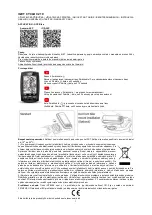
8. ROAD SAFETY
•
For your safety, always wear a helmet that meets Snell or American
National Standards Institute (Ansi) Z290.4 requirements. In the
event of an accident a helmet can protect you from serious injury
and even death. A bicycle retailer will be happy to assist you in the
selection of a helmet and other useful accessories.
•
Obey all traffi c laws. Obey red and green lights, one-way streets,
stop signs, etc.
•
Ride with the traffi c, not against it. Ride single fi le in a straight line.
•
Have a satisfactory signaling device (bell, horn, etc.), to warn of
approach. RIDE DEFENSIVELY (expect the unexpected).
•
Give pedestrians the right of way. Do not ride too close to
pedestrians and alert them if you intend to pass from behind.
•
Slow down at all street intersections and look to the right and left
before
crossing.
•
Always use proper hand signals for turning and stopping. Give
signals 100 ft. before stopping or turning and always return both
hands to the handlebars before stopping or turning.
•
Watch for cars pulling out into traffi c and for sudden opening of car
doors.
•
Avoid potholes, drainage grates or other road surface hazards.
Cross railroad tracks at a right angle. Be careful when riding on soft
road edges, gravel, sand and uneven surfaces. Ride slowly and
avoid quick turns when riding on these surfaces.
8. ROAD SAFETY
•
Never hitch on other vehicles, do not “Stunt” ride or race in traffi c.
Don’t weave in and out of the traffi c or swerve from side to side.
•
Never carry other riders or packages, they may obstruct vision or
proper control of the bicycle.
•
Before riding, check your brakes. Be sure they are operating
effi ciently and that your bicycle is in perfect running condition.
•
When riding at night, always use lights, clear light on front and
fl ashing red light on rear, and wear light colored and/or refl ective
clothing. Make sure your refl ectors are intact and visible. Assume
motorists are unable to see you and ride in an appropriately
cautious
manner.
•
When braking always apply stronger braking pressure to the rear
wheel (right lever). If the front brake pressure (left lever) is applied
too strongly or quickly, the bicycle may fl ip forward. Avoid strong
braking while turning.
CAUTION IN WET WEATHER RIDING
No brakes work as well under wet conditions as they do under dry conditions.
In rainy wet weather, special precautions must be taken to insure safety in
stopping. Proper adjustment and cable lubrication will help, but the major
precaution rests with you. Increased brake pressure is required in wet or
rainy weather and care must be exercised to maintain safety under these
conditions.
Ride slower than normal and apply your brakes sooner than normal
conditions would require.
A crash can put extraordinary stress on bicycle components, causing
them to fatigue prematurely. Components suffering from stress fatigue
can fail suddenly, causing loss of control, or serious injury.
19.
20.
Use your front brake properly to ensure safe, effi cient stopping. To avoid
misuse and potential injury, do not apply sudden or excessive force on
your front brake. To do so may cause your rear wheel to lift off the ground
and/or, your front wheel to slip from under you.
WARNING
Your bicycle is equipped with refl ectors, however, extreme caution is re-
quired when travelling at dusk or night. In addition to keeping your refl ec-
tors clean, and properly affi xed to your bicycle, you must use headlights
and taillights, in addition to wearing bright, refl ective clothing when riding in
poor lighting conditions. Consult your local bike shop to fi nd accessories
appropriate for your riding needs.
WARNING






































